Product development history
Here is a history of product development that began with the extraction of natural vitamin A and has grown to meet changing dietary and social needs.
1949
Extraction of natural vitamin A
Our company’s business began with the extraction of natural vitamin A from fish liver.
Later, when synthetic vitamin A was developed overseas, we diversified into businesses which built on our experience with natural vitamin A.
(We do not currently produce vitamin A.)
- Food
- Improving Agents
- Health Care
1950’s
1950
Started industrialization of concentration, extraction of fish-liver oil.
1953
Succeeded in molecular distillation of vitamin A.
Started production of vitamin A through molecular distillation.
(1953)
A molecular distillation system was installed at our Tokyo Factory, which began operations in the same year. We began to produce vitamin A. With the subsequent facility expansion and improvements in molecular distillation technology, our production volume increased spectacularly.
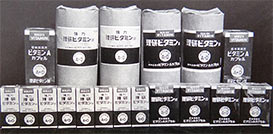
1955
Molecular distillation system installed in Tokyo Factory.
Production of high-unit vitamin A begins.
1958
Success in producing vitamin A in powder form using large spray dryers.
Establishment of vitamin A acetate crystallization technology.
1959
Started Japan's first production of high-purity monoglycerides through molecular distillation.
Started production of high-purity monoglycerides. (1959)
Applying the molecular distillation technology we gained through vitamin A production, in 1959 we became the first in Japan to manufacture distilled monoglycerides.
In 1966, we were honored to receive the 12th Okochi Memorial Production Award for the commercial production of distilled monoglycerides using domestic technology.
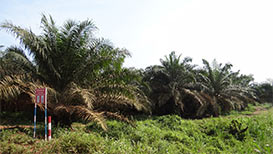
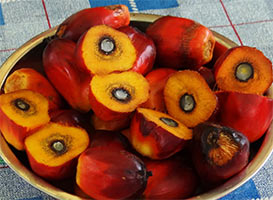
1959
Completed development of meat extract manufacturing technology.
Started production of soup for instant ramen noodles.
Started production of soup for instant ramen noodles.
(1959)
Capitalizing on the extraction, refinement, and concentration technologies gained through vitamin A production from marine sources, we began the business of producing whale extract.
To add value to the whale extract, we began to produce ramen soup. This coincided with soaring sales of instant ramen during that period, and our production could barely keep up with demand.
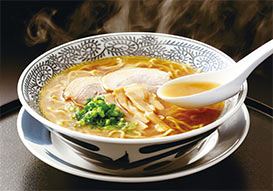
1960’s
1961
Started production of medical microcapsules (vitamin A beads).
Started production of medical microcapsules.
(1961)
Microcapsule equipment was completed in our Tokyo Factory and we began production of vitamin A beads for medical use (at the time). (We do not currently produce vitamin A.)
1962
Completed structure to increase production capacity of monoglyceride.
Launch of feed oil for aquaculture.
1964
Released commercial "Riken Soup Stock".
Released commercial "Riken Soup Stock".
(1964)
We launched the product as a seasoning for school lunches, canteens, and high-end restaurants. Mainly consisting of powdered chicken, beef, and whale extract, it was the first product bearing our company name that was produced for the food industry.
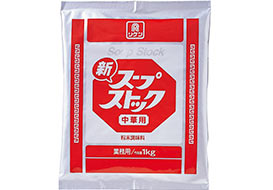
1965
Entered the wakame business, and released "Nama Wakame (fresh wakame) Wakame-chan".
Entered the wakame business, and released "Nama Wakame (fresh wakame) Wakame-chan".
(1965)
Our procurement of ingredients for vitamin A (fish liver oil) created channels for marine resources, and we began to handle wakame, which was beginning to be farmed at the time.
Delivering the freshness of just-harvested wakame, we launched Nama Wakame (fresh wakame) Wakame-chan® as our first product for household use. Our urban customers had never tasted such wakame before, and they were hooked.
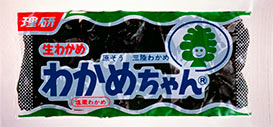
1966
Won "Okochi Memorial Production Award" for commercialization of distilled monoglycerides production using domestic technology.
1966
Released Japanese soup stock granules for consumers.
Released Japanese soup stock granules for consumers.
(1966)
We launched our Japanese-style soup stock, which we had already commercialized for industrial use harnessing our extract and seasoning technologies, as a consumer product.
Right from its launch, consumers loved the product for its bursting bonito flavor and convenience.
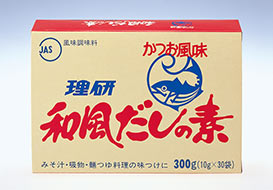
Developed water dispersible vitamin A.
1969
Entered into chemical improving agents market.
Expansion into chemical improving agent business (establishment of Chemicals Business Department)
(1969)
Chemical improving agents, which we had originally developed for use in food, were applied to industrial purposes such as anti-fogging for agricultural film and better workability for plastic materials.
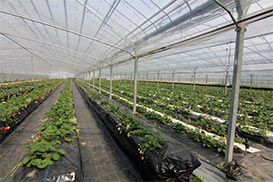
1969
Released commercial "Demi-glace Sauce".
1970’s
1970
Released water dispersible distilled monoglycerides.
Commercialized microcapsules for health foods.
Commercialized microcapsules for health foods.
(1970)
We commercialized our microcapsules for health foods. They are manufactured using our proprietary technology which can stabilize unstable materials.
1972
Released "Mabo-Tofu no moto Mabo-chan" for consumers.
1973
Developed a new lubricant for construction plastics, such as pipes.
1975
Released commercial Dried Wakame "Hanazaiku".
1976
Released natural colorants.
Released natural colorants
(1976)
We launched “Lycesin Y5S”, a natural yellow colorant made from gardenia fruit, and entered the natural colorant market. In 1985, we began integrated production of Monascus pigments at our Kyoto Factory. Today, our product lineup includes paprika and marigold pigments. Using our emulsifiers and emulsification technology, we have a range of products that can meet our customers' needs.
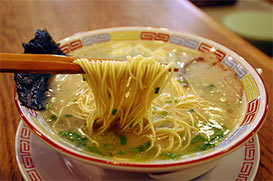
1976
Developed scallop extract.
Developed scallop extract.
(1976)
We partnered with a fisheries co-op in Hokkaido to develop a full-flavored scallop extract. We then strengthened our production frameworks to develop it into an indispensable flavoring that serves as the secret ingredient in a wide range of products including wakame soup and dressings.
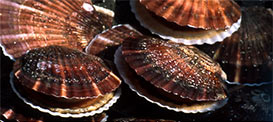
Released Dried Wakame "Fueru Wakame-chan" for consumers.
Released Dried Wakame "Fueru Wakame-chan" for consumers.
(1976)
We launched our curly dried wakame, a revolutionary product to meet the market need for a more convenient wakame product with a longer shelf life. From the outset, we provided a wide range of menu ideas to accompany this product marketed for use in the home. In addition to miso soup, people use this long-selling product in ramen, soba noodles, Western and Chinese style soups, and salads.
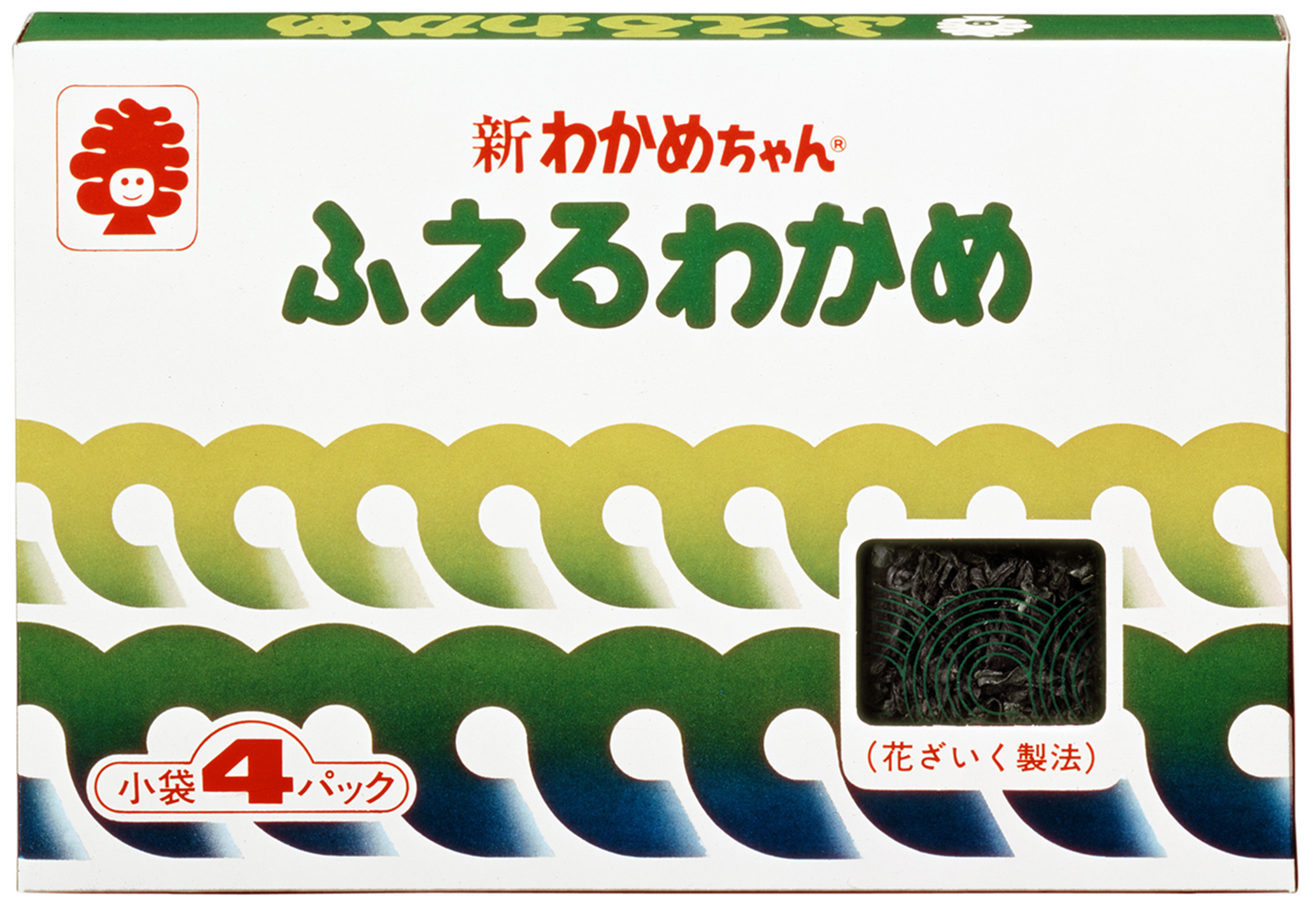
1977
Released commercial "Potage Ace Cone".
1979
Released commercial "Chicken Broth".
1980’s
1980
Completed the installation of a fully automated molecular distillation system in the Osaka Factory.
1980
Released commercial "Bechamel Sauce".
Released commercial "Bechamel Sauce".
(1980)
White sauce can be used not only in Japanese cream stews but also in clam chowder, au gratin, and many other dishes. The current product contains cheese and butter and is even creamier than before.
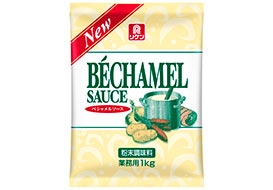
1981
Released "Wakame Soup" for consumers.
Released "Wakame Soup" for consumers.
(1981)
Instant soup consisting of small packets of “Fueru Wakame®” and soup granules flavored with Hokkaido scallop extract.
Sales exploded as soon as the product was launched, and the product won the Japan Food Journal’s 1982 Hit Food Product Award.
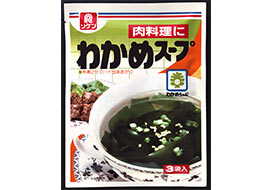
1982
Released "Mabo-Nasu no moto" for consumers.
"Wakame Soup" won the "Superior Hit Product Award" of the "Hit Food Product Award".
1983
Installed ultra-low temperature spray cooler in Osaka Factory.
Developed a colorant from Monascus purpureus.
Tokyo Factory expanded to include pharmaceutical GMP facility.
Constructed facility for vitamin E in the Chiba Factory.
Started a full-scale production of vitamin E.
Started a full-scale production of vitamin E in the Chiba Factory.
(1983)
A facility for vitamin E extraction and refinement was completed in the Chiba Factory, and full-scale production began. Vitamin E is used for a wide range of purposes including pharmaceutical products, health foods, nutritionally fortified foods, and antioxidants.
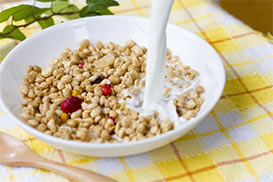
1988
Completed construction of a fully automated system for monoglyceride production in Chiba Factory.
1988
Released "Katsuo-chan granule" Japanese soup stock granules for consumers.
1989
Released traditional Japanese sweets mix.
Started production of the additive master batch.
Started production of the additive master batch.
(1989)
It is a product for blending various compounding agents into different kinds of resins. These include anti-fogging agents to prevent food wrap from clouding due to condensation, and anti-static agents to prevent problems due to buildup of static electricity.
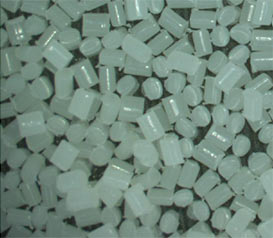
1989
Released "Non-Oil Super Dressing (current Riken Non-Oil) with Aojiso" for consumers, which subsequently won the "Superior Hit Product Award" of the "Hit Food Product Award".
Released "Non-Oil Super Dressing (current Riken Non-Oil)" for consumers.
(1989)
Riken Non-Oil Aojiso was developed as a seasoning to enjoy with seaweed. Consumers loved its versatility with any type of menu, and it became a mega-hit product as soon as it was launched, establishing the brand-new category of “non-oil dressing” which had not existed before.
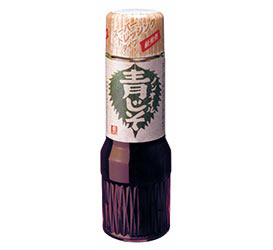
1990’s
1992
Released functional improving agents for bread.
Released bacteriostic agents.
1993
Started production of distilled monoglycerides at Rikevita (Malaysia) Sdn. Bhd.
1994
Released Chuka Hyakusen series of Chinese seasonings for consumers.
1995
Full-scale rollout of fish sauce.
Full-scale rollout of fish sauce
(1995)
In 1995, we began the manufacture and sales of our Sea Best® series of fish sauces made from white-fleshed fish.
The sauce adds distinctive body and depth to foods. (Fish sauce: Seasoning made by fermenting salted fish and allowing the mixture to mature)
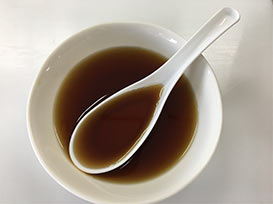
2000’s
2000
Released "Sozairyoku (current Sozairyoku Dashi)" Japanese soup stock granules for consumers.
Released "Sozairyoku (current Sozairyoku Dashi)" Japanese soup stock granules for consumers.
(2000)
This product features the natural flavor of dashi and has no added chemical flavors or salt. Since its launch, it has won the approval of people who are conscious of their health and salt intake, and who refuse to compromise on the natural flavor of ingredients.
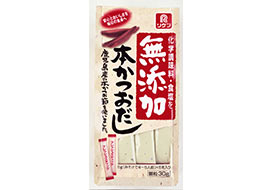
2002
Released Mekabu fucoidan.
Released Mekabu fucoidan for health foods.
(2002)
It is a viscous ingredient extracted from mekabu (fertile leaves of wakame). Riken Vitamin has continued research with a focus on fucoidan, the health-functional ingredient contained in Mekabu, which has been familiar among the Japanese since ancient times.
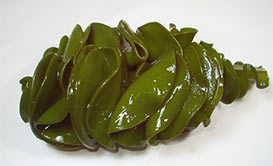
2004
Added extra production line for high-purity monoglycerides at Rikevita (Malaysia) Sdn. Bhd.
2004
Released "Non-Oil Super Dressing Selecty (current Riken Non-Oil Selecty)" for consumers.
Released "Non-Oil Super Dressing Selecty (current Riken Non-Oil Selecty)" for consumers.
(2004)
They were launched as our Non-Oil Dressing series with full-bodied, mellow taste in a home-made style, maximizing the flavors and textures of the ingredients.
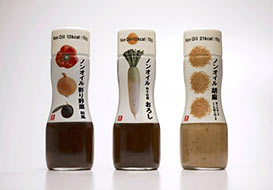
2005
Developed an additive for biodegradable plastics.
2005
Released commercial Frozen Sanriku Marudori Wakame.
2005
Released Foods for Specified Health Uses (FOSHU) "Wakame Peptide Jelly".
2006
Developed and released yellow colorant products derived from gardenias (Crocetion) for health foods.
Released gardenia fruits extract "Crovit" (Crocetin) for health foods.
(2006)
Crocetin is a pharmacologically active carotenoid compound of gardenia fruits, which used as natural food colorant. Leveraging our many years of experience in the manufacture and sale of gardenia yellow, we have developed a high-crocetin-content gardenia fruits extract, and have launched it as Crovit for health food manufacturers. Crocetin is currently attracting attention as an ingredient in foods with function claims.
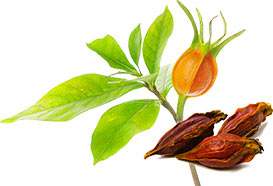
2007
"Wakame Soup" and instant soup "Osuimono" were certified as Japanese Space Foods.
2008
Released the "Crocetion Eye" supplement.
2009
Released the plasticizer "Biocizer".
Released the plasticizer "Biocizer".
(2009)
Made primarily from vegetable oil, it is a high-biomass (renewable resource) plasticizer which works to add softness and flexibility to hard plastics. It has a wide range of applications from food containers to flooring and cladding materials.
2010’s
2010
Constructed a new plant for producing chemical improving agents at Kenseido Co., Ltd.
2011
Released Wakame Soup Roasted Sesame Flavor for consumers.
2012
Constructed esterification plant for chemical improving agents at Tianjin rikevita Food Co., Ltd.
2013
Development of SaFE pesticides (joint research) won the "National Merit Award of MEXT in Science and Technology".
2013
Launched pork extract in the North American market.
Rollout of pork extract for the U.S. ramen market
(2013)
The pork extract produced at Guymon Extracts is marketed to the rapidly growing North American ramen market. At our distribution hub in Los Angeles (Riken Vitamin USA), we also do test production of ramen using pork extract.
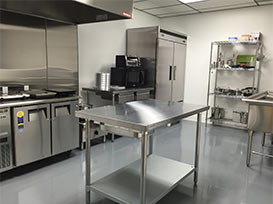
2014
Our Frozen Seaweed series for industrial use wins the Excellent Commercial Processed food Award.
2015
Released Food with Function Claim "Wakame Peptide Granulated Type".
Released Food with Function Claim "Wakame Peptide Granulated Type".
(2015)
Launched under the new framework started in April 2015. It is a Food with Functional Claims suitable for persons with slightly elevated blood pressure.
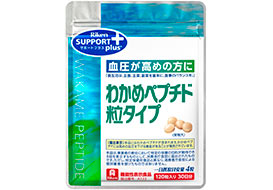
2016
Launched the brand “Tokimeki Kaisoya”.
2019
Our Riken Non-Oil Dressing Aojiso wins the Long Seller Heisei Contribution Award.
We begin the use of the Geographical Origin Test Pass Logo on our Fueru Wakame-chan.
Released commercial “Sanriku Wakame Fries (frozen) ”.
2020’s
2020
“Sanriku Wakame Fries” won the “Restaurant Industry Contribution Award” .
2021
Opened a medical microcapsule facility at the Tokyo Factory
2022
Released Furikake Wakame “Furikakeru Zakuzaku Wakame Korean-style sesame oil flavor” for consumers.
2023
“Furikakeru Zakuzaku Wakame Korean-style sesame oil flavor” won the "Superior Hit Product Award" of the "Hit Food Product Award".
Released Dressing “Indo Kareya-san no Nazo Dressing” for consumers.
Our “Yasai ippai Indo Kareya-san no Nazo Dressing” for industrial use wins the Excellent Commercial Processed food Award.
2024
“Indo Kareya-san no Nazo Dressing” won the "Superior Hit Product Award" of the "Hit Food Product Award".
Riken Vitamin will continue to grow through innovative product development with a focus on our three core businesses of Food, Improving Agents, and Healthcare.
-
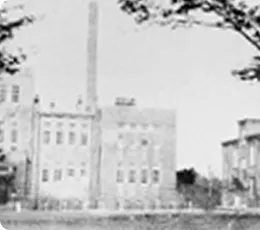
History
Here is an introduction to the history of Riken Vitamin, from our founding in 1949 to the present.
Here is an introduction to the history of Riken Vitamin, from our founding in 1949 to the present.
